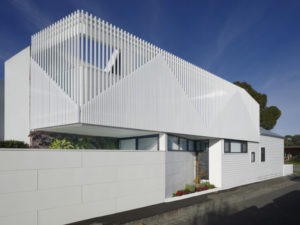Reduce, reuse, recycle a contribution in the latest Venice Architecture Biennale that makes you think. And then there is this building in Berlin
Zehlendorf, vacant for years. It has endured several moultings before it shed its skin and is reused once more. Built in the 70ties for
business and production it followed a functional purpose: Staff area on lower ground floor, naturally lit by the shape of the topography, a
big hall for delivery with machine shop on the ground floor and offices on the first floor. A lot of daylight everywhere. A clear grid with
strong beams to keep the space free of any columns, exposed concrete without any visual requirements. Than its first moulding: at some
point the building became too small for the business, and so it was reused as the embassy of Mongolia. They wanted to convert it but the
project fell by the wayside. An unfinished skinning to stick with the metaphor. Left behind was a building left to decay: inside, graffiti and
water damages through bursted pipes, damages to the façade caused by overflowing rain gutters, overnight guests leaving behind evidences,
boarded windows as all windows were smashed and completely overgrown. And all of this happening in a city with a housing
shortage, in the middle of a high end residential area.
Time for the wrecking ball? Replaced by two townhouses in historic style which are so in demand in this kind of area? No. Time for another
moulding ! A comparable use of the site would not be granted planning today. Despite the decay the structure was still sound. And more
than that, it has a certain charm. The vacant house was striped to its core but the skinnings with the rough concrete of the structure, the
skylights, the staircase with its terrazzo tiles and, with an ironic wink, the flag polls in the front yard remained visible.
Today, after eight months of construction the house is used for living. On the ground floor a patio is placed between two living areas. A
ceiling slab was removed to create a gallery between ground- and first floor. This all creates interesting views in every direction. A grannyflat
is to be found where the former staff area was located. Its living space merges into a terraced landscape. Kitchen-, dining-, and living
area with library stretch deep through the building and provide very different moods of daylight. The series of beams allow the old machine
shop to be tangible. Necessary rooms set in a wooden box are clearly divided from the crude concrete of the rest of the building by a visible
joint. They remain elusive, more a gift box or furniture than rooms. The private area with master bedroom and bathroom is located on
the upper floor. The rooms are only separated by a built in wardrobe with a sliding door that allows the space to be open or closed off. The
Gallery is also a working space and opens onto the roof of the lower part of the building. Standing in front of the house the neighboring
buildings appear relatively close but from the inside the only thing you see through the accentuated openings is the surrounding greenery.
So far the skinnings were only utilitarian. Now an actual second skin is added. To comply with building regulations the building received a
mineral insulation and a timber cladding with rough boards glazed in black. The new skin unifies the former moultings as well as the different
building volumes. Various widths of the boards prevent the windows from cut outs. The windows sit either flush with the façade or
deep in the reveals. This makes the buildings plasticity perceptible both, from the outside and the inside. Some selected openings are clad
with vertical timber louvers providing a private screen as well as sun shading. The black of the façade flows inside in the kitchen cabinets
and long built in sideboards in front of the windows. Thereby the walls appear to be thicker and stronger. Black, grey and white are the
prevailing colours, complimented by shades of yellow, green and blue. The crude concrete of the ceilings is reflected in the exposed screed
of the floor.
The exterior extends the play with plains, terraces, materiality and colours. A black gate, concrete, black gravel, timber decks. Various
plains, once as a basin for rainwater and again as an almost artificial, geometrical lawn. The rest are grasses and perennial plants flourishing
in different colours. A mighty stock of trees is shaping the character of the building as a black box in the greenery.
The House came alive once more and has probably some more lives, some more skinings ahead of itself. And this is something in our
through-away-society.
Reanimation
Reanimation
- Zehlendorf
- Berlin
- Germany
Used materials
- Wood











